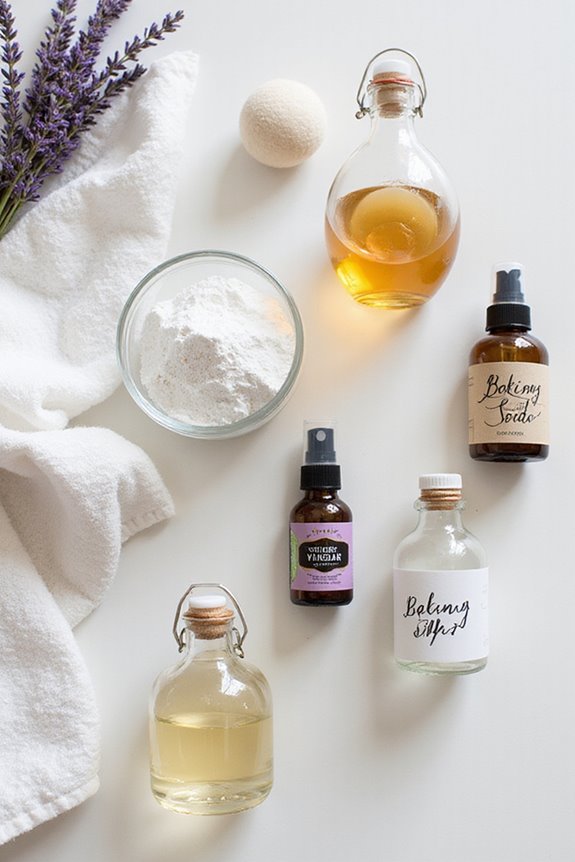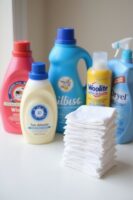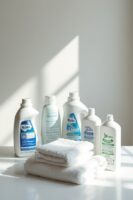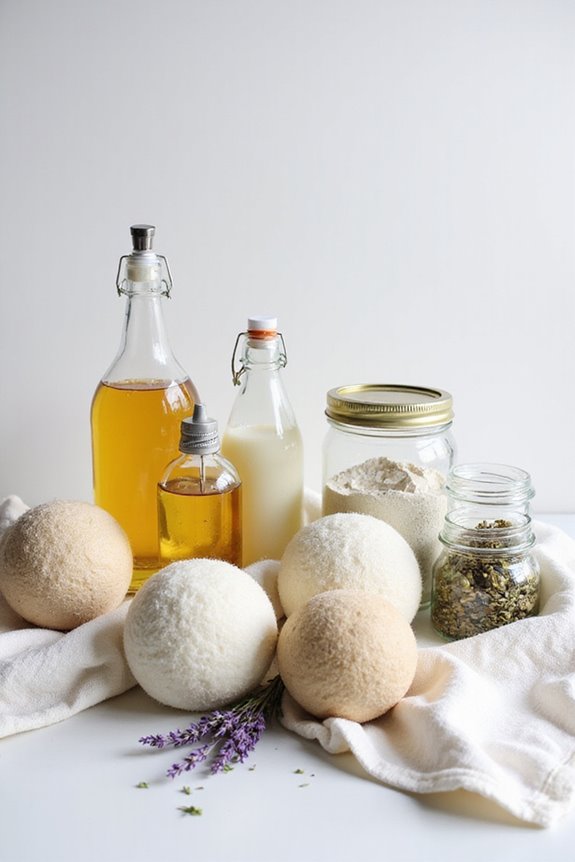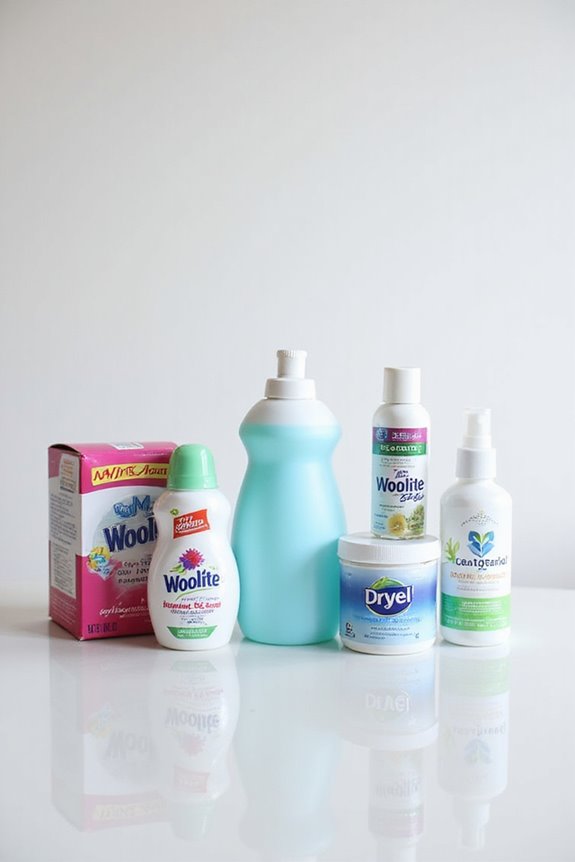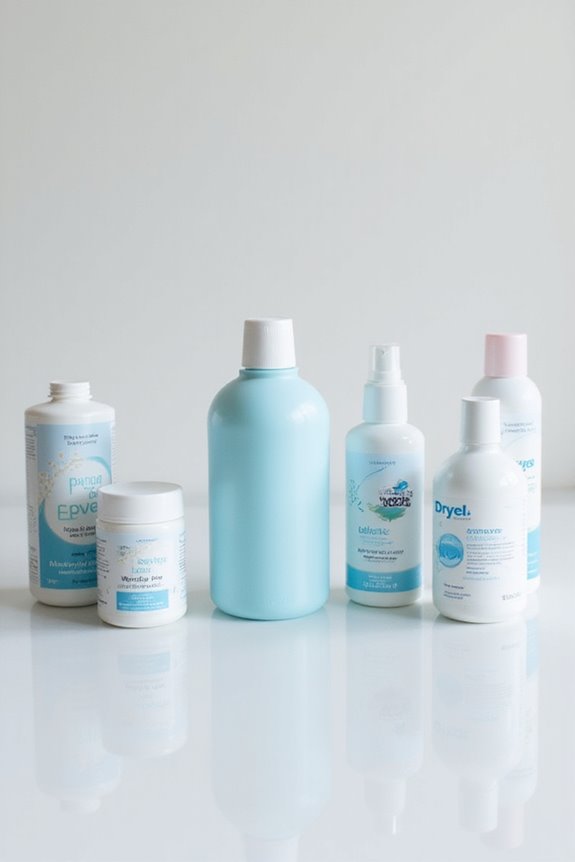If you’re looking for homemade fabric softener recipes, we’ve got you covered! One popular option is mixing equal parts white vinegar and water, then adding your favorite essential oil for a fresh scent. Another great choice is a baking soda and vinegar solution, which softens and neutralizes odors. We love experimenting with different scents, and it’s money-saving too! Stick around, and you’ll discover more fun recipes and tips to keep your laundry fresh and eco-friendly!
Key Takeaways
- Combine 2 to 4 cups of white vinegar with 10 to 90 drops of essential oils for a simple homemade fabric softener.
- Mix 1 cup of baking soda with vinegar and water for an effective softening solution while adding your favorite scents.
- Use low-scent, sulfate-free hair conditioner mixed with vinegar and water for extra softness in your laundry.
- Store your homemade fabric softener in glass jars, shaking well before each use to maintain freshness.
- Opt for biodegradable ingredients and reduce plastic waste by making your own fabric softener instead of buying commercial products.
Benefits of Homemade Fabric Softeners
When we think about doing laundry, we often overlook the benefits of using homemade fabric softeners. These natural alternatives not only soften our clothes but also protect our health and the environment. By ditching harsh chemicals found in commercial options, we reduce chemical pollution and support sustainable practices. Plus, using ingredients like vinegar and baking soda is cost-effective and often already in our cupboards!
We’ve even noticed allergy relief since switching—no more rashes or respiratory issues from synthetic fragrances. Homemade fabric softeners are gentle on sensitive skin, making them safe for kids and pets too. Additionally, many commercial fabric softeners contain dyes and synthetic fragrances that can irritate skin, so opting for homemade solutions can be particularly beneficial. With these benefits, we can enjoy fresher laundry while caring for ourselves and the planet. Who knew laundry could be so rewarding?
Essential Ingredients for DIY Fabric Softener
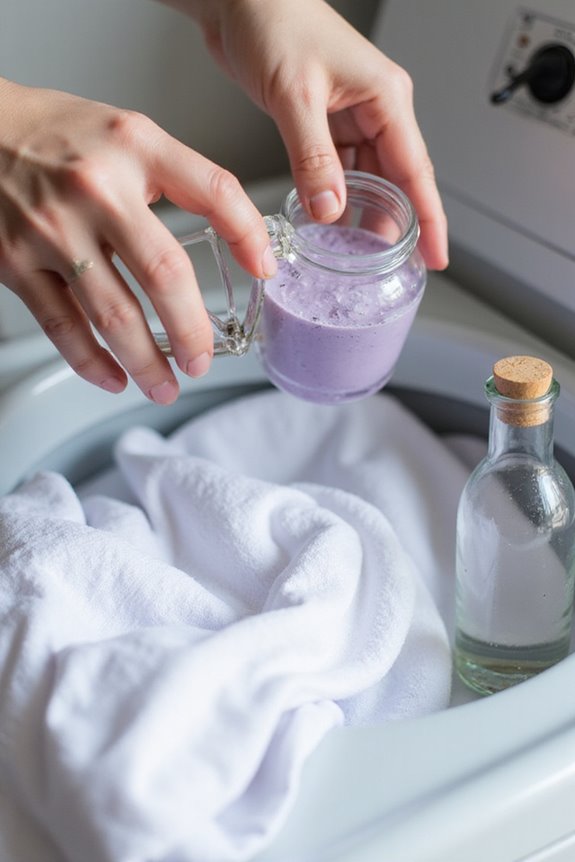
DIY fabric softeners can be a game-changer for our laundry routine, and it all starts with a few essential ingredients. First up is vinegar, a natural alternative that cuts through detergent residues and brightens our clothes. We usually opt for white distilled vinegar, about 1 to 3 cups depending on our recipe. Next, baking soda helps soften our laundry while neutralizing odors, typically used in 1 to 6 cups. Hair conditioner brings extra softness; we prefer low-scent, sulfate-free options. Finally, essential oils are our go-to for fragrance options. Whether we choose lavender or eucalyptus, just 10-30 drops can transform our DIY softener into a fragrant delight. With these ingredients, our laundry routine just got a whole lot better! Additionally, using natural fabric softener sheets can enhance the freshness of our clothes while being gentle on sensitive skin.
Simple Vinegar and Essential Oils Recipe
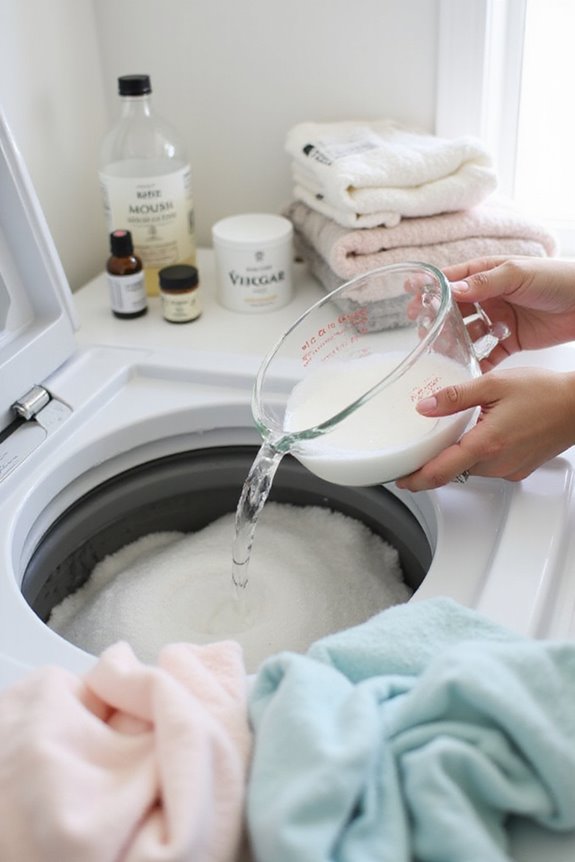
Let’s explore a simple recipe that combines the power of vinegar and essential oils to create an effective fabric softener. First, we’ll use 2 to 4 cups of white vinegar, known for its amazing vinegar properties. It softens clothes and removes residues without any harmful chemicals. To make it smell great, we’ll add 10 to 90 drops of our favorite essential oils. Lavender and lemon are fantastic choices!
We can mix these ingredients in a safe container, shaking well before each use. Adding about 1/4 to 1/2 cup of this blend during the rinse cycle will keep our laundry fresh and soft. Plus, the vinegar smell disappears once the clothes dry—no more stinky surprises! This homemade softener is also eco-friendly and biodegradable, making it a great alternative to commercial products.
Baking Soda and Vinegar Softener
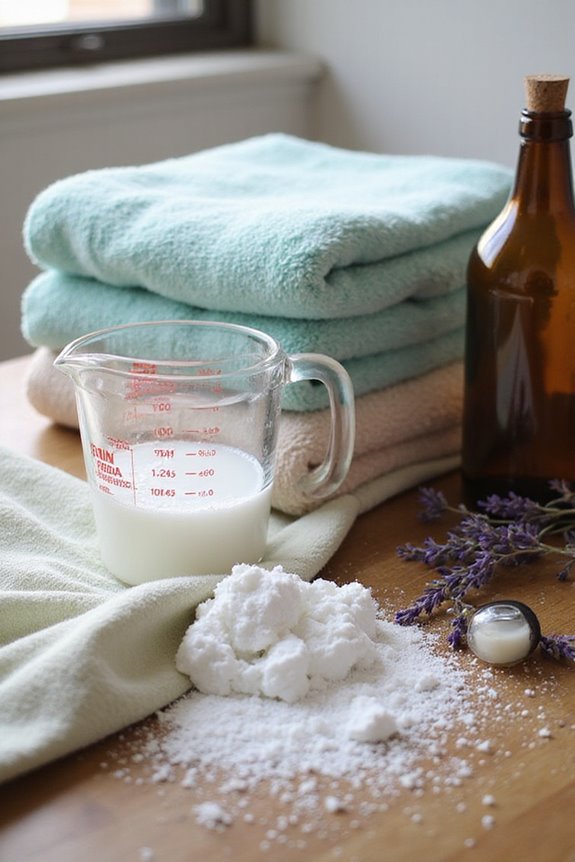
While vinegar and essential oils are great for fabric softening, baking soda brings its own unique benefits to the laundry room. It’s a natural deodorizer that helps neutralize odors, making our clothes smell fresher. Plus, it softens water, which enhances detergent effectiveness and fabric feel. When we mix 1 cup of baking soda with vinegar and water, we create a powerful softening solution that can tackle various fabric types. We can even add scent options like lavender or lemon for a lovely fragrance! Just remember to dissolve the baking soda in warm water first to avoid foaming. This eco-friendly combo saves us money while keeping our laundry clean and soft, all without harsh chemicals. Additionally, using plant-based fabric softeners can further enhance our sustainable laundry routine.
Salt-Based Fabric Softener Solution
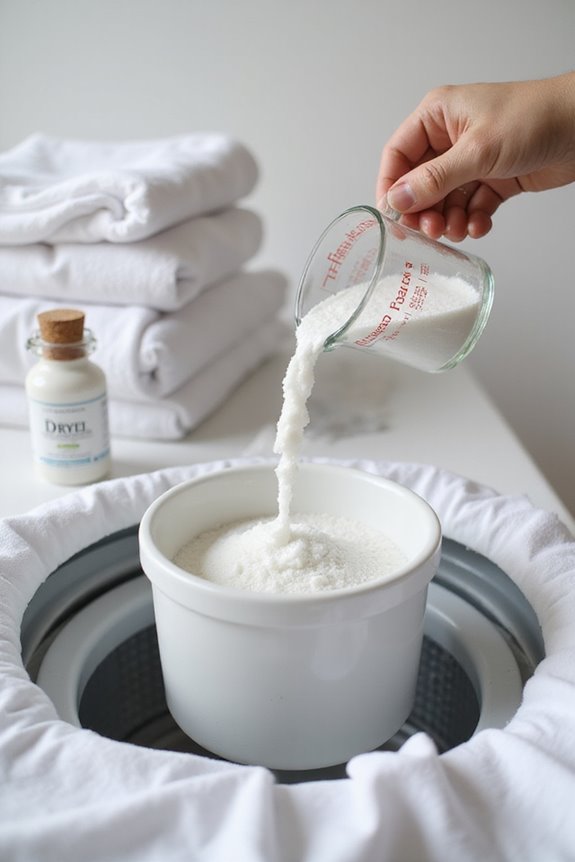
Salt-based fabric softeners are a fantastic way to soften our laundry without relying on harsh chemicals. Using coarse sea salt or kosher salt, we can create a gentle yet effective solution. We start by dissolving salt in hot, distilled water, which helps with salt dissolution. Adding white vinegar enhances the softening properties while deodorizing our clothes. We can toss in a few drops of essential oils for a fresh scent.
When it comes to dosage, we typically use 1-2 tablespoons for small loads and up to a 1/2 cup for larger ones. This solution not only softens fabrics but also reduces static. Plus, it’s safe for our machines and sensitive skin—so we can wash worry-free!
Lavender and Baking Soda Mix
If you’re looking for a natural way to soften your laundry, the Lavender and Baking Soda mix is a great option. This combination not only softens fabrics but also adds a fresh scent, thanks to the lavender benefits. We can easily whip it up with just a few ingredients: lavender essential oil, baking soda, vinegar, and water.
Baking soda uses go beyond just softening; it helps neutralize odors and boosts detergent effectiveness. To prepare, we dissolve baking soda in hot water, mix the lavender oil with vinegar, and combine both mixtures carefully. Just add about 1/4 to 1/2 cup during the rinse cycle, and voilà! Our laundry smells amazing, and we’ve avoided chemicals found in store-bought products. Additionally, using plant-based ingredients ensures that our homemade softener is gentle on sensitive skin.
Hair Conditioner Fabric Softener
When we think about keeping our clothes soft and smelling great, hair conditioner isn’t usually the first thing that comes to mind, right? But believe it or not, using hair conditioner types in our fabric care routine can be a game-changer! We can mix about 1 to 3 cups of conditioner with 5 to 6 cups of hot water, adding vinegar for extra softness and deodorizing power. This homemade fabric softener can give us about 30-40 loads of laundry, all while costing around $0.03-$0.05 per load. And let’s not forget, it’s eco-friendly! So, next time we’re at the store, let’s grab some affordable conditioner and get creative. Our clothes will thank us!
Tips for Preparing and Storing Softener
Preparing and storing our homemade fabric softener doesn’t have to be complicated, especially since we want our clothes to feel and smell great without any hassle. First, let’s use vinegar and baking soda in our preparation techniques. When mixing, we’ll add baking soda slowly to vinegar to control that fizzy reaction—trust us, it’s fun! For storage tips, glass jars are a great choice; they keep our softener fresh. Remember to store them in a cool, dry place and label each jar clearly. Consistency is key, so let’s shake or stir the mixture well before each use. And don’t forget, using distilled water helps prolong shelf life, keeping our homemade creations effective longer. Happy softening!
Environmental and Cost Benefits of DIY Solutions
Making our own fabric softeners not only gives us the chance to be creative, but it also brings along some fantastic environmental and cost benefits. By choosing natural, biodegradable ingredients, we protect aquatic life and reduce water pollution. Plus, we avoid harmful chemicals that can damage our air quality. Additionally, using DIY fabric softeners aligns with the principles of ingredient transparency, ensuring we know exactly what we are putting into our laundry.
On the cost side, DIY solutions can lead to significant cost savings. We can use common household items like vinegar and baking soda, which are inexpensive and often multi-use. Making only what we need helps cut down on waste and unnecessary spending.
Embracing sustainable practices not only benefits our wallets but also helps the planet. So, let’s get crafty and do our part for the environment while saving some cash!
Frequently Asked Questions
Can I Use Homemade Fabric Softener in High-Efficiency Washers?
Yes, we can use DIY fabric softeners in high-efficiency washers! They’re compatible when used correctly, with about 1/4 cup per load. Just remember to add them during the rinse cycle for best results.
How Long Does Homemade Fabric Softener Last?
When it comes to shelf life, homemade fabric softeners typically last about one year. To maximize longevity, we should follow storage tips like using airtight containers and keeping them in dark, cool places.
Will Homemade Fabric Softeners Stain Clothes?
Studies show that over 30% of people experience staining fabrics from improper fabric softener use. To avoid residue, we should always dilute our homemade softeners and never apply them directly onto clothes.
Can I Mix Different Essential Oils Together?
Absolutely, we can mix different essential oils together! By using blending techniques and experimenting with essential oil combinations, we can create unique scents tailored to our preferences while ensuring safety and effectiveness in our mixtures.
Is Homemade Fabric Softener Safe for All Fabrics?
When it comes to fabric types, homemade fabric softeners aren’t universally safe. We should be aware of safety concerns, especially with delicate fabrics and those with elastic. Testing on small patches is always a smart idea.

